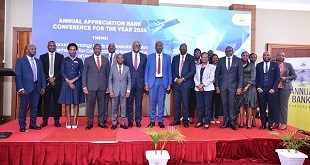
Kampala, Uganda | THE INDEPENDENT | The government has finalized the second National Financial Inclusion Strategy, aimed at increasing access to financial services.
The strategy due for launch on Thursday will cover the period 2023 to 2028, succeeding the first one that was launched in 2017.
According to Mackay Aomu, Director, of the National Payment Systems Department at BoU, major achievements were met by the previous strategy, though they were affected by the outbreak of COVID-19, as well as budget constraints and inadequate accountability.
“Under the new strategy, implementing agencies will be tasked to ensure ear accountability and budgetary allocations for initiatives,” Aomu says.
The new strategy was drawn with the aim of reducing poverty and promoting economic growth through affordable and quality financial services.
This, according to Aomu, should be achieved through expanding the usage of savings, credit, insurance, remittances, pensions, investment, and Islamic banking financial products and services.
The document provides special attention to women, youth, persons with disabilities, refugees, micro, small and medium enterprises, and rural communities, segments considered highly underserved.
Most of the objectives are extensions of the previous strategy.
“While significant progress has been made in expanding delivery channels and reducing exclusion barriers, the new strategy should focus on deepening formal access, usage, and quality of financial services,” he says.
On the achievements of the previous strategy, the BoU prides itself on what it calls greater access to financial services as well as the increase in the number of Ugandans now using formal or regulated channels.
“We saw a rapid increase in access points. One of them is agent banking, if you go back to 2017, you will recall how we used to line up to pay school fees, now we have about 32,000 bank agents and over 500,000 mobile money agents supporting access to financial services,” says Alex Patrick Ochan, Assistant Director, Financial Inclusion Division in the National Payment Systems Department.
The new strategy was developed after conducting surveys that featured 50 respondents including regulated financial institutions, government entities, research groups, and humanitarian organizations.
Diana Akullu Wanyama, Intervention Manager, Market Infrastructure at the Financial Sector Deepening Uganda, says the achievements of the NFIS1 can be enhanced by leveraging on the new developments in and around the financial sector.
She cites the system to enable verification of National ID cards by Financial Service Providers which has been enabled by the National Identification Registration Authority (NIRA) and the National Information Technology Authority Uganda (NITA-U).
“Verification of National IDs by financial institutions breaks down the barriers that prevent some people from accessing financial services. NFIS II should focus on upgrading the current e-KYC (electronic Know-Your-Customer) platform for improved customer validation and authentication,” she says.
She also calls for a strategy implementation that will take advantage of the move by the Uganda Registration Services Bureau to register movable properties for use to access credit.
“The establishment of a centralized registry for movable collateral has been achieved in line with the Movable Property Security Interest Act 2019. NFIS II should focus on raising awareness about the centralized registry and its benefits for borrowers with movable assets.”
She, however, reminds the government agencies of the growing challenges of cybersecurity, urging for stronger data protection measures through closer collaboration between the government and NITAU.
“The evolving finance landscape in the areas of technology, regulation, and socioeconomic factors such as digital transformation, data privacy, and security, innovation, inclusion of unregulated entities, targeting vulnerable populations, and rural and remote access calls for continued evaluation for effective implementation.”
*****
URN
 The Independent Uganda: You get the Truth we Pay the Price
The Independent Uganda: You get the Truth we Pay the Price


